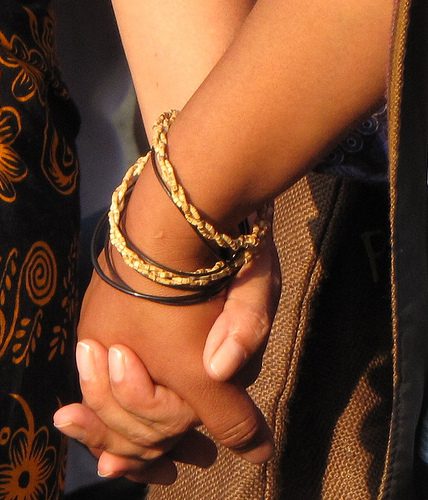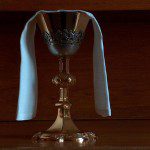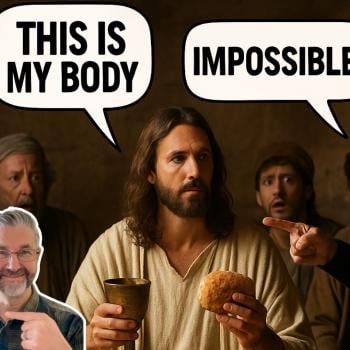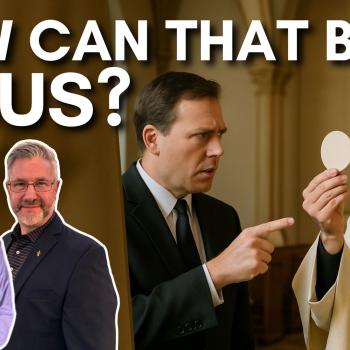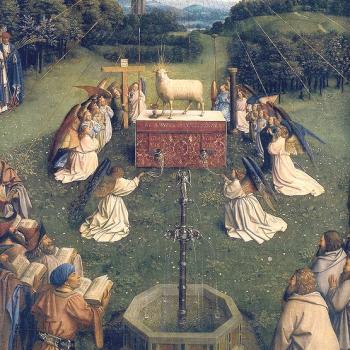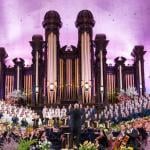Original title: “Orans” Posture and Hand-Holding During the “Our Father” Are Against the Rubrics (Instructions) for the Mass
Photo by B Hartford J Strong (11-30-08) [Flickr / CC BY 2.0 license]
(7-7-08)
* * * * *
Colin B. Donovan, STL, over at the EWTN website, states that the “orans’ posture in the congregation (arms outstretched in a “praying” or adoration position) is contrary to the rubrics:
The liturgical use of this position by the priest is spelled out in the rubrics (the laws governing how the Mass is said). It indicates his praying on BEHALF of us, acting as alter Christus as pastor of the flock, head of the body. . . .
It is never done by the Deacon, who does not represent the People before God but assists him who does.
Among the laity this practice began with the charismatic renewal. Used in private prayer it has worked its way into the Liturgy. It is a legitimate gesture to use when praying, as history shows, however, it is a private gesture when used in the Mass and in some cases conflicts with the system of signs which the rubrics are intended to protect. The Mass is not a private or merely human ceremony. The symbology of the actions, including such gestures, is definite and precise, and reflects the sacramental character of the Church’s prayer. . . .Our Father. The intention for lay people using the Orans position at this time is, I suppose, that we pray Our Father, and the unity of people and priest together is expressed by this common gesture of prayer. Although this gesture is not called for in the rubrics, it does at least seem, on the surface, to not be in conflict with the sacramental sign system at the point when we pray Our Father. I say on the surface, however, since while lay people are doing this the deacon, whose postures are governed by the rubrics, may not do it. So, we have the awkward disunity created by the priest making an appropriate liturgical gesture in accordance with the rubrics, the deacon not making the same gesture in accordance with the rubrics, some laity making the same gesture as the priest not in accordance with the rubrics, and other laity not making the gesture (for various reasons, including knowing it is not part of their liturgical role). In the end, the desire of the Church for liturgical unity is defeated.
After Our Father. This liturgical disunity continues after the Our Father when some, though not all, who assumed the Orans position during the Our Father continue it through the balance of the prayers, until after “For thine is the kingdom etc.” The rubrics provide that priest-concelebrants lower their extended hands, so that the main celebrant alone continues praying with hands extended, since he represents all, including his brother priests. So, we have the very anomalous situation that no matter how many clergy are present only one of them is praying with hands extended, accompanied by numbers of the laity.
So, while we shouldn’t attribute bad will to those who honestly have felt that there was some virtue in doing this during the Mass, it is yet another case where good will can achieve the opposite of what it intends when not imbued with the truth, in this case the truth about the sacramental nature of the postures at Mass and their meaning.
Catholic apologist Jimmy Akin, in an article about postures during the Our Father, agrees, and provides more documentation:
The Holy See has been concerned about the laity unduly aping the priest at Mass, and in the 1997 Instruction on Collaboration, an unprecedented conjunction of Vatican dicasteries wrote:
6 § 2. To promote the proper identity (of various roles) in this area, those abuses which are contrary to the provisions of canon 907 [i.e., “In the celebration of the Eucharist, deacons and lay persons are not permitted to say the prayers, especially the eucharistic prayer, nor to perform the actions which are proper to the celebrating priest.”] are to be eradicated. In eucharistic celebrations deacons and non-ordained members of the faithful may not pronounce prayers — e.g. especially the eucharistic prayer, with its concluding doxology — or any other parts of the liturgy reserved to the celebrant priest. Neither may deacons or non-ordained members of the faithful use gestures or actions which are proper to the same priest celebrant. It is a grave abuse for any member of the non-ordained faithful to “quasi preside” at the Mass while leaving only that minimal participation to the priest which is necessary to secure validity.
This instruction, incidentally, was approved by John Paul II in forma specifica, meaning that the pope invested it with his own authority and is binding on us with the pope’s authority and not merely the authority of the authoring congregations.
Now, what gestures are proper to the priest celebrant? The orans gesture when praying on behalf of the people is certainly one of them.
An article in Adoremus Bulletin offers yet more proof that this is an abuse:
Many AB readers have been asking about the orans posture during the Our Father (orans means praying; here it refers to the gesture of praying with uplifted hands, as the priest does during various parts of the Mass).
In some dioceses in the United States, people are being told that they should adopt this gesture, though it is not a customary posture for prayer for Catholic laity. Sometimes people are told that their bishop mandates this change because the new General Instruction of the Roman Missal (GIRM) requires it or at least encourages it.
Thus it may be helpful to review the actual regulations on the orans posture.
What does the GIRM say?First of all, nowhere in the current (2002) General Instruction of the Roman Missal (GIRM) does it say that the orans posture is recommended for the congregation during the Our Father.In GIRM 43 and 160, the paragraphs dealing with the people’s posture during Mass, the only posture specified for the congregation at the Lord’s Prayer is standing. It says nothing at all about what people do with their hands. This is not a change from the past.
The confusion arose among bishops in the 1990s, when some were suggesting the orans position in the ICEL Sacramentary, but not in the new Roman Missal. But even the Sacramentary revision was “specifically rejected by the Holy See after the new Missal appeared.” The article continues:
At their November 2001 meeting, the bishops discussed “adaptations” to the new Institutio Generalis Missalis Romani (or GIRM) of the new Missal (reported in AB February 2002). The proposal to introduce the orans posture for the people was not included even as an option in the US’ “adaptations” to the GIRM.
Furthermore, the bishops did not forbid hand-holding, either, even though the BCL originally suggested this in 1995. The reason? A bishop said that hand-holding was a common practice in African-American groups and to forbid it would be considered insensitive.
Thus, in the end, all reference to any posture of the hands during the Our Father was omitted in the US-adapted GIRM. The orans posture is not only not required by the new GIRM, it is not even mentioned.
The approved US edition of the GIRM was issued in April 2003, and is accessible on the USCCB web site – http://www.usccb.org/liturgy/current/revmissalisromanien.shtmlNot on the listThe posture of the people during prayer at Mass is not one of the items in the GIRM list that bishop may change on his own authority (see GIRM 387). Thus it is not legitimate for a bishop to require people to assume the orans posture during the Our Father.
The GIRM does say that a bishop has the “responsibility above all for fostering the spirit of the Sacred Liturgy in the priests, deacons, and faithful”. He has the authority to see that practices in his diocese conform to the norms liturgical law, . . .
Holding hands during the Our Father is also clearly against the rubrics: thus should not be done on that basis alone. Catholic apologist Karl Keating wrote about this:
ORIGINS OF HAND-HOLDING
The current issue of the “Adoremus Bulletin” says this in response to a query from a priest in the Bronx:
“No gesture for the people during the Lord’s Prayer is mentioned in the official documents. The late liturgist Fr. Robert Hovda promoted holding hands during this prayer, a practice he said originated in Alcoholics Anonymous. Some ‘charismatic’ groups took up the practice.”
My long-time sense had been that hand-holding at the Our Father was an intrusion from charismaticism, but I had not been aware of the possible connection with AA. If this is the real origin of the practice, it makes it doubly odd: first, because hand-holding intrudes a false air of chumminess into the Mass (and undercuts the immediately-following sign of peace), and second, because modifications to liturgical rites ought to arise organically and not be borrowed from secular self-help groups.
Periodically, on “Catholic Answers Live” I am asked about hand-holding during Mass and explain that it is contrary to the rubrics. Usually I get follow-up e-mails from people who say, “But it’s my favorite part of the Mass” or “We hold hands as a family, and it makes us feel closer.”
About the latter I think, “It’s good to feel close as a family, but you can hold hands at home or at the mall. The Mass has a formal structure that should be respected. That means you forgo certain things that you might do on the outside.”
About the former comment I think, “If this is the high point of the Mass for you, you need to take Remedial Mass 101. The Mass is not a social event. It is the re-presentation of the sacrifice of Calvary, and it is the loftiest form of prayer. It should be attended with appropriate solemnity.”
Further comments, from interaction on the CHNI board. The words of Rick Luquette over there will be in green (official documents indented and in regular black) :
Currently the following is found from the USCCB Committee on Divine Worship:
Many Catholics are in the habit of holding their hands in the “Orans” posture during the Lord’s prayer along with the celebrant. Some do this on their own as a private devotional posture while some congregations make it a general practice for their communities.
Is this practice permissible under the current rubrics, either as a private practice not something adopted by a particular parish as a communal gesture?
No position is prescribed in the present Sacramentary for an assembly gesture during the Lord’s Prayer.
Well (to use the logical technique of reductio ad absurdum), if all gestures are left open, then could congregations spontaneously decide to hug one another during the Our Father? Or how about lifting up one arm heavenward? Or all turning towards each other (i.e., the center of the church)?
The General Instructions of the Roman Missal includes the following:
390. It is up to the Conferences of Bishops to decide on the adaptations indicated in this General Instruction and in the Order of Mass and, once their decisions have been accorded the recognitio of the Apostolic See, to introduce them into the Missal itself.
These adaptations include
The gestures and posture of the faithful (cf. no. 43 above);
The gestures of veneration toward the altar and the Book of the Gospels (cf. no. 273 above);
The texts of the chants at the entrance, at the presentation of the gifts, and at Communion (cf. nos. 48, 74, 87 above);
The readings from Sacred Scripture to be used in special circumstances (cf. no. 362 above);
The form of the gesture of peace (cf. no. 82 above);
The manner of receiving Holy Communion (cf. nos. 160, 283 above);
The materials for the altar and sacred furnishings, especially the sacred vessels, and also the materials, form, and color of the liturgical vestments (cf. nos. 301, 326, 329, 339, 342-346 above).
Directories or pastoral instructions that the Conferences of Bishops judge useful may, with the prior recognitio of the Apostolic See, be included in the Roman Missal at an appropriate place.
So it appears that at present, there is no recommended position for the hands of the faithful at the Our Father.
I should think it is obvious that it would be either hands at the side or clasped or in the hands-joined prayer position. But is not the orans position specifically prohibited, since it is imitating the posture of the priest? As Colin B. Donovan wrote (as I cited):
. . . since while lay people are doing this the deacon, whose postures are governed by the rubrics, may not do it. So, we have the awkward disunity created by the priest making an appropriate liturgical gesture in accordance with the rubrics, the deacon not making the same gesture in accordance with the rubrics, some laity making the same gesture as the priest not in accordance with the rubrics, and other laity not making the gesture (for various reasons, including knowing it is not part of their liturgical role). In the end, the desire of the Church for liturgical unity is defeated.
Also, Jimmy Akin cited the 1997 Instruction on Collaboration (specifically approved by Pope John Paul II):
Neither may deacons or non-ordained members of the faithful use gestures or actions which are proper to the same priest celebrant. It is a grave abuse for any member of the non-ordained faithful to “quasi preside” at the Mass while leaving only that minimal participation to the priest which is necessary to secure validity.
That precludes the orans position, though it itself doesn’t seem to prohibit hand-holding (because the priest is not doing that at this time). What is your counter-explanation for that? What you decline to call any abuse at all is called “abuses” and “a grave abuse” by this papally-approved document. If bishops say otherwise, then the faithful Catholic still has the right to appeal to Church-wide proclamations from the Vatican, which carry more authority than bishops, and are to be followed in cases of contradiction. Some priests, however, have refused to give communion to a kneeling recipient, when the Church has specifically stated that all Catholics have a right to receive kneeling. The document above also made reference to Canon 907 from the Catholic Code of Canon Law:
Can. 907 In the eucharistic celebration deacons and lay persons are not permitted to offer prayers, especially the eucharistic prayer, or to perform actions which are proper to the celebrating priest.
Lacking specific instruction from the competent authority (the USCCB) you quote Jimmy Akin as saying holding hands during the Our Father is contrary to the rubrics. Following the link you provided to his article, he states:
Standing means standing without doing anything fancy with your arms.
This appears to be his rationale for declaring that holding hands is against the rubrics. Unfortunately, he does not give any authoritative reference for this statement. To the best of my knowledge, the definition of the word “standing” does not include “without doing anything fancy with your arms”.
Let me cite him at greater length from this article:
Standing means standing without doing anything fancy with your arms. It is distinct, for example, from the orans posture, which the priest uses when he stands and prays with arms outstretched. It is also distinct from the hand-holding posture.
The latter is not expressly forbidden in liturgical law because it is one of those “Please don’t eat the daisies” situations. The legislator (the pope) did not envision that anybody would try to alter the standing posture in this way. As a result, the practice is not expressly forbidden, the same way that standing on one foot and hopping up and down as an effort to get closer to God in heaven is not expressly forbidden.
In general what liturgical documents do is to say what people should be doing and not focus on what they should not be doing (though there are exceptions). To prevent “Please don’t eat the daisies” situations, what the law does is prohibit things that aren’t mentioned in the liturgical books. Here’s the basic rule:Can. 846 §1. In celebrating the sacraments the liturgical books approved by competent authority are to be observed faithfully; accordingly, no one is to add, omit, or alter anything in them on one’s own authority.
Akin is not the magisterium, of course, but he is a highly respected apologist who has written a book about rubrics in the Mass (Mass Confusion: The Do’s and Don’ts of Catholic Worship; San Diego: Catholic Answers, 1999). He also regularly cites folks like canon lawyer Dr. Edward Peters (who has written about liturgical confusion and need for further codification).
He also says:
Changing from standing to hand holding during the Lord’s Prayer would be an alteration or addition of something provided for in the liturgical books and thus would be at variance with the law.
Sneezing is an addition not provided in the liturgical books either. Standing and hand-holding are not either/or positions; they are both/and. I can hold hands while I stand.
I can also hug, kiss, clasp my hands far above my head, make a peace sign, clench my fists, point my fingers towards the priest with arms outstretched, or straight up, pick wax out of my ear, scratch my head, comb my hair, wave, put my hands on my waist (like an outfielder in baseball) and do any number of things while standing, that are not mentioned, either. Quite obviously a line has to be drawn somewhere. If these things were spontaneously introduced by the laity during Mass, then the Church has a right to more specifically define what can or can’t be done (and folks should be reasonable in interpreting what “standing” means).
Isn’t it common sense, anyway that “stand” means standing without implied reference to anything else (though not necessarily precluding gestures)? If one is, for example, told to stand in a courtroom, they wouldn’t stand in the orans posture or hold someone’s hands while standing, or put their hands on the top of their head. It would never cross their mind. So why would it be different in church?
I can assume the Orans posture while standing.
Not (or so it seems) according to Canon 907 and the high-level Instruction on Collaboration and deductively from the fact that even a deacon cannot do so. The laity can spontaneously do what a deacon cannot do?
Zenit, in a Q & A with Father Edward McNamara, professor of liturgy at the Regina Apostolorum Pontifical Athenaeum, provides the following:
Some readers asked if the U.S. bishops’ vote against allowing the “orantes” posture meant that this gesture was forbidden in the United States. The bishops, in deciding not to prescribe or suggest any particular gesture during the Our Father, did not therefore proscribe any particular gesture either.
The bishops’ conference decision does limit the possibility of another authority such as a pastor or even a diocesan bishop from prescribing this gesture as obligatory. But it need not constrain an individual from adopting the “orantes” posture nor, in principle, stop a couple or small group from spontaneously holding hands.
While holding hands during the Our Father is very much a novelty in the millenarian history of Catholic liturgy, the “orantes” posture, as one reader from Virginia reminds us, is as old as Christianity, is depicted in the catacombs, has always been preserved in the Eastern rites and was not reserved to the priest until after several centuries in the Latin rite — and even then not everywhere.
The controversy regarding the use of the “orantes” posture for the Our Father appears to be confined to the English-speaking world. In many other places, it is pacifically accepted as an optional gesture which any member of the community is free to perform if so inclined.
I think this is interesting in light of the other things mentioned above. I’d sincerely like to see how Fr. McNamara harmonizes them.
So the Orans (or orantes) posture is not forbidden; it is a historical posture of the Church, and it is commonly accepted throughout the world.
It was not a common posture during Mass, according to canon lawyer Edward Peters, who observed:
While the orans position as such has a rich tradition in Jewish and even ancient Christian prayer life, there is no precedent for Catholic laity assuming the orans position in Western liturgy for at least a millennium and a half; that point alone cautions against its introduction without careful thought. Moreover — and notwithstanding the fact that few liturgical gestures are univocal per se — lay use of the orans gesture in Mass today, besides injecting gestural disunity in liturgy, could further blur the differences between lay liturgical roles and those of priests just at a time when distinctions between the baptismal priesthood and the ordained priesthood are struggling for a healthy articulation.
The previous Zenit article in the series includes the following statement from Fr. McNamara regarding the Orans/Orantes posture:
Despite appearances, this gesture is not, strictly speaking, a case of the laity trying to usurp priestly functions.
The Our Father is the prayer of the entire assembly and not a priestly or presidential prayer. In fact, it is perhaps the only case when the rubrics direct the priest to pray with arms extended in a prayer that he does not say alone or only with other priests. Therefore, in the case of the Our Father, the orantes posture expresses the prayer directed to God by his children.
The U.S. bishops’ conference debated a proposal by some bishops to allow the use of the orantes posture while discussing the “American Adaptations to the General Instruction to the Roman Missal” last year. Some bishops even argued that it was the best way of ridding the country of holding hands. The proposal failed to garner the required two-thirds majority of votes, however, and was dropped from the agenda.
Fr. McNamara adds that this posture is accepted and officially recommended in Italy, with Vatican approval.
As I have said before, I am not in favor of holding hands during the Our Father. I accept the Orans posture but would quite happily do without it. However, given that there are no instructions to the contrary (and the document quoted by Mr. Akin is intended to address a completely different issue), I see no prohibition against it.
Then I look forward to your counter-explanations of what I have reiterated above. Thanks for the discussion.
***


